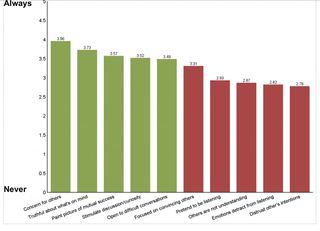By Judith E. Glaser | Psychology Today and Huffington Post
Published: December 16, 2016
We are all familiar with the ‘chemistry’ factor in relationships and the chemical attraction metaphor; however, we are now learning that our insights about the chemical nature of relationships and conversations are more than a metaphor—they are a reality!
For many decades, I’ve been intrigued by the chemical impacts—both positive and negative—that conversations have on us. I married a biochemist and we’ve shared lots of conversations about our work. When we first wrote about the “Neurochemistry of Positive Conversations” for the Harvard Business Review and Psychology Today, we received confirmation that we were on to something important.
Positive comments and positive conversations provide a chemical “high,” and yet negative ones stick with us much longer. A critique from a boss, a disagreement with a colleague, or a fight with a friend can make you forget praise. If you are called lazy, careless or unprofessional, you are likely to remember it and internalize it, making it not very easy to forget, and discounting all the times people say you’re talented.
Chemistry plays a big role in this reaction. When we face criticism, rejection or fear, when we feel marginalized or minimized, our bodies produce higher levels of cortisol, a hormone that shuts down the thinking center of our brains and activates conflict aversion and protection behaviors. We become more reactive and sensitive. We often perceive greater negativity than exists. These effects can last for days, imprinting the interaction on our memories and magnifying its impact on our future behavior. Cortisol functions like a sustained release tablet—the more we ruminate about fear, the longer the impact.
Positive comments and positive conversations also produce a chemical reaction. They spur the production of oxytocin—a feel-good hormone that elevates our ability to collaborate, communicate, and trust others by activating networks in our prefrontal cortex. But, since oxytocin metabolizes faster than cortisol, its effects are less dramatic and sustainable.
Chemistry of Conversations
This ‘chemistry of conversations’ is why we need to be more mindful of our interactions. Behaviors that increase cortisol levels reduce our conversational intelligence or C-IQ—our ability to connect and think innovatively, empathetically, creatively and strategically with others. Remember: behaviors that spark oxytocin boost C-IQ.
When we partnered with Qualtrics, the online survey software company, to analyze the frequency of negative (cortisol-producing) versus positive (oxytocin-producing) interactions, we found that managers appear to be using positive, oxytocin and C-IQ elevating behaviors more often than negative behaviors. Survey respondents said that they exhibited all five positive behaviors, such as ‘showing concern for others’ more frequently than all five negative ones, such as ‘pretending to be listening.’ However, about 85 percent of respondents also admitted to sometimes acting in ways that could derail not only specific interactions but also future relationships. And, when leaders exhibit both behaviors, they create dissonance or uncertainty in followers’ brains, spurring cortisol production and reducing C-IQ.
If you tend to tell and sell your ideas and challenge people to produce results, your negative (cortisol-producing) reactions could easily outweigh positive (oxytocin-producing) reactions. Instead of asking questions to stimulate discussion, showing concern for others and painting a compelling picture of shared success, you tend to enter discussions with a fixed opinion, determined to convince others you are right. You are not open to others’ influence—and you fail to listen to connect.

This graph is from our Creating WE Institute Research into the Chemistry of Conversations. Red bars = cortisol producing, Green bars = oxytocin producing. The highest red bar is “focusing on convincing others.” Not only is it done more often, its impact is 26 times that of the oxytocin producing behaviors—suggesting that this one act alone can cause a relationship or sales engagement to go south.
Three Chemistry Lessons
When managers and leaders learn about the chemical impacts of their behavior, they tend to make changes—for example, they learn to deliver difficult feedback in a way that is perceived as inclusive and supportive, thereby limiting cortisol production and stimulating oxytocin instead.
As we become mindful of the behaviors that open us up and those that close us down, and their influence in our relationships, we can better harness the chemistry of conversations. Mindfulness about our conversational impact enables us to get on the same page with others, strengthens our relationships – and expands our potential for higher levels of engagement and innovation. Without healthy conversations, we shrivel up and die. Conversations are the source of energy that moves us out of our doldrums when we are sad, the power that launches transformational products, and the golden threads that enable us to trust others. But these threads can be fragile and also unravel, causing us to run from others in fear of loss and pain. Conversations are the way we connect, engage, navigate, and transform the world with others.
“The quality of our culture depends on the quality of our relationships, which depends on the quality of our conversations. Everything happens through conversations.” The most powerful ‘leadershift’ we can make is to realize that each person has the power to create the conversational space that creates deeper understanding and engagement, not fear and avoidance.
Three Chemistry Lessons
Remember these three chemistry lessons:
1. Be mindful of your conversations and the emotional content you bring—either pain – which closes the brain, or pleasure which opens the brain.
Are you sending friend or foe messages? Are you sending the message “You can trust me to have your best interest at heart” or “I want to persuade you to think about things my way?” When you’re aware of these meta-messages, you create a safe culture that allows all parties to interact collaboratively, sharing perspectives, feelings, and aspirations and elevating insights and wisdom.
2. Conversations trigger emotional reactions.
Conversations carry meaning—and meaning is embedded in the listener even more than in the speaker. Words cause us either to bond and trust more fully, thinking of others as friends and colleagues, or to break rapport and think of others as enemies. Your mind will open as you see the connection between language and health, and you’ll learn how to create healthy organizations through your conversational rituals.
3. Note that the words we use in our conversations are rarely neutral.
Words have histories informed by years of use. Each time a new experience overlays another meaning on a word, the information all gets collected in our brains to be activated during conversations. Knowing how you project meaning into your conversations will enable you to connect with others and, in so doing, let go of much of the self-talk that diverts you from working together effectively.
Judith E. Glaser is CEO of Benchmark Communications, Inc. and Chairman of The CreatingWE Institute; an Organizational Anthropologist, consultant to Fortune 500 Companies, and author of four best-selling business books, including Conversational Intelligence: How Great Leaders Build Trust and Get Extraordinary Results. Visit:www.conversationalintelligence.com; Contact: This email address is being protected from spambots. You need JavaScript enabled to view it. or call 212-307-4386.









